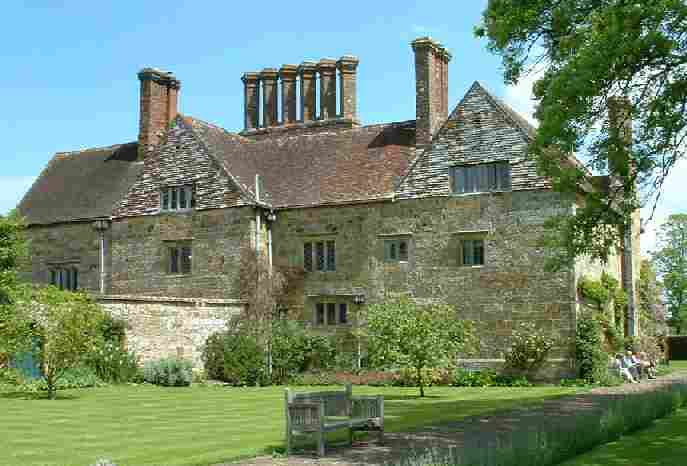|
BATEMANS
- RUDYARD KIPLING
HOME
| SITE
INDEX
Bateman's,
is close to the village of Burwash
in East Sussex. It is thought the house was built by a Wealden ironmaster,
or iron dealer, named John Britten, at a time when the Sussex Weald, with its
forests for charcoal, was a flourishing centre of the
ancient English iron industry. There is much evidence of forges
in the area. It is also, perhaps, not a coincidence that
there are many Sussex ironbacks and firedogs by the
fireplaces in the house. The date over the porch
is: AD 1634, as an indication of when the house was
built.
Surrounded
by the wooded landscape of the Sussex Weald, Bateman's
is an idyllic spot in the Dudwell Valley. Owned and
loved by Rudyard Kipling, Bateman's became his sanctuary.
A
member of his family once said "the house stands
like a beautiful cup, on a saucer to match". Kipling,
like the Baron de Roemer, at Lime Park, Herstmonceux,
installed electricity at a time when the grid had not
been established.

Batemans
- Rudyard Kipling's Sussex retreat
Bateman's is
built largely of local sandstone, the tiles of the
hipped roofs and six chimneystacks are made from Weald
clay, and the floorboards, staircase and wood paneling are from
Sussex oak.
The oak tree grows in such abundance in this part of the
country that it is nicknamed 'the Sussex Weed'. Mullioned windows, pilasters, and the round arch of the
porch give, a hint of the Renaissance. The front
entrance is not symmetrical, as there is a gabled wing
on the south side, but not on the north. On the outer
left-hand pier of the porch are the carved initials of
the family.
Rudyard Kipling settled in the
house in 1902 with his American wife, and lived there for over thirty years,
until his death, rejoicing in its seclusion under the
Sussex downs, and in the evidence all around of
thousands of years of English history.
Although the seclusion
this house offered was perfect, the home comforts at
that time were few, with no electricity, no running
water upstairs, and no bathroom. A feature which Kipling
had no intention of changing, however, was the lack of a
telephone in the house. Furthermore, the abundance of
open fireplaces throughout the house provided a useful
means of disposal for the manuscripts that Kipling did
not want the world to see.
"It was the
heartbreaking Locomobile that brought us to the house
called 'Bateman's', he wrote in Something of Myself.
We had seen an advertisement of her, and we reached her
down an enlarged rabbit-hole of a lane. At very first
sight the Committee of Ways and Means [Mrs Kipling and
himself] said 'That's her! The only She! Make an honest
woman of her - quick!'. We entered and felt her Spirit -
her Feng Shui - to be good. We went through every room
and found no shadow of ancient regrets, stifled
miseries, nor any menace though the 'new' end of her was
three hundred years old...

Batemans
- Sussex countryside
The heart of
Kipling's house was the study, where he wrote many of
his famous works and where favoured friends
were invited to sit whilst he worked. His collection of
books cover a most interesting, and wide-ranging, array
of subjects from rat catching to manures, or from gates
and fences to bridges. It is known that, when Kipling
had tired of his guests, he liked to take them into the
garden to look at the sundial. After noticing the
inscription "it is later than you think" they,
hopefully, took the hint to be quickly on their way!
Despite his wish for peace and seclusion, Kipling did
enjoy entertaining visitors and many were welcomed over
the years. Among the most famous of them was Stanley
Baldwin, the Conservative Prime Minister, and cousin to
Rudyard Kipling.
The
Rose Garden
The avenue of pleached limes had been planted in 1898
before Kipling arrived, but the pond, the Rose Garden at
the far end and the encircling yew hedges were all laid
out according to his own design, which still hangs in
his study. The garden was paid for from £7,700 he
received for the Nobel Prize in 1907.
Today,
the visitor can still enjoy the terraced lawns, the
walled garden, the working watermill, and his beautiful
1928 Rolls Royce, as well as the many personal
possessions remaining in the house moreorless as he left
them on this death in 1936.
Batemans
- Burwash, East Sussex Tel: (01435) 882302 Fax:
(01435) 882811
Opening
times:
23rd March - 29th September. Closed Thursdays and
Fridays except Good Friday. 11.00 am - 5.30 pm last
entry 4.30 pm.
LINKS:
Battle
Abbey
Battle
Museum of Local History
Batemans
Bexhill
Museum
Bexhill
Museum of Costume & Social History
Bodiam
Castle
Buckleys
Yesterdays World
Carr
Taylor Vineyards
Clambers
De
La Warr Pavilion
Farmworld
Great
Dixter
Hastings
Castle
Hastings
Fishermen's Museum
Hastings
Museum & Art Gallery
Herstmonceux
Castle
Kent
& East Sussex Railway
Merriments
Gardens
Old
Town Hall Museum
Pashley
Manor Gardens
Pevensey
Castle
Rye
Art Gallery
Rye
Audio Walks
Rye
Castle Museum
Rye
Story
Underwater
World - Hastings
Sedlescombe
Vineyards
Shipwreck
Heritage Centre
Smugglers
Adventure
White
Rock Theatre
Winchelsea
Court Hall Museum
Herstmonceux
Electricity Generating Works Circa. 1900 - 1936
Introduction
| Instructions
| ISBN
| Batteries
| Boiler
Room | Floor
Plan | Ron
Saunders
Industrial
Revolution
| Lime
Park | Machinery
| Map
| Power
House | Argus
1999
Public
Supply | Roof
Construction | Rural
Supply | Sussex
Express 1913 |
Conclusion
Archaeology
South East |
East Sussex CC
| English Heritage
| SIAS
| Sx Exp 1999
Herstmonceux
Links Page
Wentworth
House
|